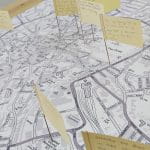Starting writing
- Students often say that starting is the hardest part of writing.
- However, tips such as getting out initial thoughts, forming titles and planning ahead may help.
- See the trifold guide and sections below for information on how to get going.
Organising thoughts
- Try mind mapping or listing initial ideas.
- Form questions about the topic with Who? What? When? Where? Why? How?
- Examples: When and where did it occur? Who were the key figures?
- Another technique is to divide a page in half. Use the left-hand side to capture your current knowledge; use the right-hand side for areas you could research.

Building a title
- Titles often feature the following parts:

- Instruction: this may be an instruction verb such as discuss, compare or evaluate. Alternatively, you may have a question word such as ‘how’ or ‘why’.
- Topic: this is the main area of research.
- Focus/aspect: this narrows down your general topic. For example, you could consider specific practitioners, genres, aspects or time periods.
- Use the title template and instruction verbs (University of Kent, 2008) below for initial ideas.
Planning a structure
- There are many ways to plan writing.
- Look at the examples below, and pick a method that works for you.
- See a summary of the techniques in the guide to planning.

Outline planning
- Make a list of the main points you wish to cover.
- Consider which evidence could support these points.
- Experiment with the order of the points.
- Which sequence is most logical?
Visual planning
- Try making a mind map of the whole structure or each section.
- Different branches in the mind map could become paragraphs in your writing.
- See the video below about how to make mind maps.
- You could also make a storyboard of the main points.
- Create images to represent points. If desired, write prompt headings underneath.
- See the example below for Dr Marten footwear.

Flexible planning
- Use index cards or post-it notes to write down key points.
- Similar to outline planning, you can also bullet point evidence to use.
- Move the points around until you are happy with the order.
- Additionally, make PowerPoint slides to see an overview of the whole structure. Each slide can represent a point and be easily reorganised.
Overcoming the blank page
- Students often say that starting is the hardest part of writing.
- Try Peter Elbow’s (1998) technique of freewriting; this involves writing without stopping or worrying about typos.
- Set realistic writing targets for each study session e.g. complete paragraph on defining sustainable fashion; proofread document for minor errors.
- Set a timer and aim to keep writing for the duration. Try a particular technique such as the Pomodoro method, which suggests setting a timer for 25 minutes and having a short break. Read more about the Pomodoro method (opens in a new window).
Sources consulted
- Cooper, H. and Schoolbred, M. (2016) Where’s your argument? Basingstoke: Palgrave.
- Elbow, P. (1998) Writing with power. Oxford: Oxford University Press.
- Gillet, A. (2019) Understanding the task. Available at: https://www.uefap.org/preparing-understanding-task/ (this link opens in a new window) (Accessed: 31 July 2024).

eBooks:
Find out more about writing at university here: https://tinyurl.com/tkhop65
